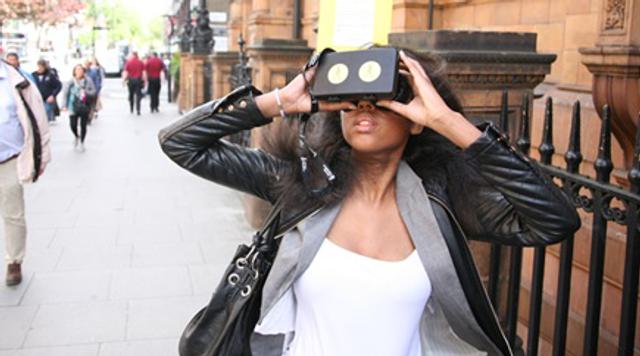Amnesty International UK: Virtual reality street fundraising
- Exhibited by
- Reuben Steains
- Added
- July 28, 2015
- Medium of Communication
- Face-to-face (F2F) fundraising
- Target Audience
- Individual donors
- Type of Charity
- Human rights
- Country of Origin
- UK
- Date of first appearance
- May 2015
SOFII’s view
It can sometimes be hard to relate to problems that are far from home, especially when they are on a scale that is difficult to imagine. This is an issue that many charities face when fundraising.
Amnesty International UK have found an engaging and imaginative way to bring the horrors and reality of barrel bombing in Syria to life. The emotional and powerful experience that is delivered through a virtual reality (VR) headset has proved to be inspiring to donors, with people signing up to help at a much higher rate than usual. Surprisingly cheap, the technology can be used over and over again to bring the reality of human rights abuses direct to donors.
There are numerous uses for the VR technology in fundraising. It is up to fundraisers to harness the possibilities for your own cause.
Creator / originator
Amnesty International UK’s in-house team
Summary / objectives
Using virtual reality headsets, individuals are transported to Syria and exposed to the devastation caused by barrel bombs. As the official Amnesty International UK (AI UK) press release states:
Barrel bombs – oil drums, fuel tanks or gas cylinders filled with explosives and metal fragments, plunged from helicopters – have killed more than 11,000 civilians in Syria since 2012.
People in the city of Aleppo, Syria, are being bombarded in their homes, schools, public markets and places of worship.
“It became routine for the helicopter to be there above us, so I finally stopped looking up. I smelled death everywhere.”
Resident of Bustan al-Qasr neighbourhood, Aleppo city
This is the gruesome reality for thousands of women, men and children in Syria, but it’s a million miles from the reality for us here in the UK.
Working with peaceful activists in Syria who strive to protect civilians in areas being heavily bombed, we’ve introduced a new street fundraising tool that aims to bring this issue closer to home.
The objectives of this project are:
- To bring people closer to human rights issues in a way they can’t ignore. To make them feel as though they are there.
- To increase the number of people who stop on the street to speak with Amnesty fundraisers.
- To increase action and donation sign-up rates as a result of a more engaging and emotive experience.
- To increase retention by creating a more memorable experience and providing content for sharing, which could lead to further online sign ups.
- To aid recruitment and increase retention of Amnesty street fundraising staff.
Background
Amnesty International UK has developed a way of having a more memorable and deeper engagement with the public with the aim of improving return on investment (ROI) for street fundraising. Activists trained by the charity have supplied 360-degree images taken using a smartphone and a free app. These images are then sent to the charity from Syria where they are shared with the public using recycled smart phones and cheap virtual reality headsets.
Overall this project aims to serve Amnesty International in three main ways:
- To empower and train activists to gather information in innovative ways.
- To provide a new way to ‘shine a light’ on human rights abuses by raising awareness and educating people about these violations and Amnesty International’s work to prevent them.
- To grow the Amnesty International movement by recruiting more supporters and raising more funds..
Special characteristics
AI UK were the first organisation to use virtual reality headsets on the street in the UK. When a potential donor put on the VR headset, Amnesty wanted him or her to feel:
- Intrigued when invited to try VR or by seeing others looking at VR.
- Awestruck by the experience when they look inside.
- Captivated when they start looking around and exploring.
- Privileged to have had this experience of seeing the world in this fresh way.
- Informed about human rights violations.
- Outraged and emotionally moved by what they have learned from powerful storytelling.
- Eager to find out more about what they can do to help.
- Generous to reciprocate their experience by donating.
As Nina, one of the street fundraisers explains:
‘It's been a real treat being the first team to use the VR headsets. It's not just the public that gets excited it's us too! It really reminds us why we, as fundraisers, are out there in the first place. The headsets are so immersive because you can't help draw comparisons between the street you're in and the street you see. The VR sets anchor everything: statistics, emotions, stories. Suddenly everything "over there" is so vivid and real, that's the power of the VR.’
Costs
The costs of the trial were surprisingly low. The image was taken on a smart phone. The Google Cardboard project meant that you only need a free app, an old mobile phone and a VR headset. These start from under £10, but Amnesty used a stronger plastic version that cost around £20.
Results
It is still early days, but the signs are encouraging. In the first week there was a 16 per cent increase in sign-ups on the street. Fundraisers are reporting more people stopping to talk and finding the experience interesting. The hope is that this emotional and immersive experience will make a lasting impression and improve retention and loyalty.
Reuben Steains, innovations manager at AI UK, said:
‘We always thought seeing these immensely affecting images would have a genuinely transformative effect on the person on the street, but the early results have surpassed our expectations.
‘We’ve had a really strong response – in a couple of cases people have been in tears and others have expressed shock and outrage at what they’re seeing in the viewers.
‘Overwhelmingly, people said that they feel more informed and educated about Syria and barrel bombs.’
Merits
This is an innovative use of a new technology that has already had a positive impact on results.
Virtual reality is an untapped concept for fundraisers and there are lots of practical ways that we could use the technology to improve donors interactions and experiences with our causes.
For example, at the time of writing Amnesty are looking at how they could use music, voices and animation to provide an even more immersive experience.
UPDATE – Sarah Littell celebrates Amnesty International VR F2F fundraising at IWITOT 2023
In addition to the detailed case study above – written by the fundraisers who created the Amnesty International’s virtual reality F2F campaign in 2015 – we are thrilled to bring you another fundraiser’s view of this amazing concept.
Sarah Littell is a legacy fundraiser, currently in her first non-profit role at Alzheimer’s Society. At I Wish I’d Thought of That (IWITOT) 2023 Sarah was one of our new voices. She spoke about why, as an early-career fundraiser, this campaign still inspires her in 2023. She also touched on how other charities like Save the Children, Alzheimer’s Research UK and The National Autistic Society are using VR technology – eight years later! – to bring donors closer to their causes too.
You can watch Sarah’s seven-minute presentation below and view her slides here.


Also in Categories
-
















